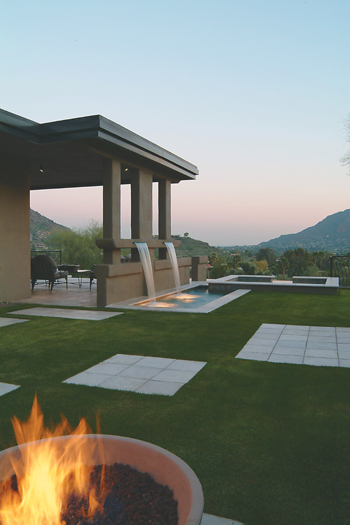weirs
It’s a rare project in which a watershaper has the opportunity to execute a complete design without compromise. In our Scottsdale, Ariz.-based business, we often work with upscale clients on custom pool and spa installations, and it seems that there’s always some element or other in the design that ends up being altered or left out. It sometimes reaches the point where we start to feel as though
Who took the water out of watershapes? That may seem a ridiculous question, but it's also an obvious one when you see as many plans as I do - and by that I mean plans intended to indicate and initiate the watershaping parts of a wide variety of projects. Indeed, in my long experience in running an engineering-oriented firm, I've repeatedly been asked by designers to flesh out their watershape "ideas" (although in most cases vague inklings would probably be a more accurate way to describe them) and provide working drawings that reflect their "thinking." In my estimation, more than three-quarters of these plans lack any real indication of what the designers expect the water to do or how they want it to look. Instead, what I get is the typical overhead views with the ubiquitous "blue ghosts" or, in some cases, rudimentary sections of structures designed to contain water. It's left to me to probe and ask questions and determine what expectations they have about how the water is to appear and what it is to do. I've endured these common plan shortcomings for more years than I care to count, always wondering
Who took the water out of watershapes? That may seem a ridiculous question, but it's also an obvious one when you see as many plans as I do - and by that I mean plans intended to indicate and initiate the watershaping parts of a wide variety of projects. Indeed, in my long experience in running an engineering-oriented firm, I've repeatedly been asked by designers to flesh out their watershape "ideas" (although in most cases vague inklings would probably be a more accurate way to describe them) and provide working drawings that reflect their "thinking." In my estimation, more than three-quarters of these plans lack any real indication of what the designers expect the water to do or how they want it to look. Instead, what I get is the typical overhead views with the ubiquitous "blue ghosts" or, in some cases, rudimentary sections of structures designed to contain water. It's left to me to probe and ask questions and determine what expectations they have about how the water is to appear and what it is to do. I've endured these common plan shortcomings for more years than I care to count, always wondering
I've always found it interesting that most of us have such a clear divide in our minds between technical and aesthetic thinking. Science tells us that our brains conduct analytical and logical thought processes on one side and creative and emotional thought processes on the other - and that certainly makes sense when you consider
From the grandest waterfall to the smallest courtyard fountain, water flowing over an edge is one of the most compelling of all watershaping “looks.” Whether it’s a vanishing edge or a slot overflow or a trough, runnel or waterfall, these effects all use one common concept – that is, the weir. Simply defined, a weir is a barrier or dam placed in a channel behind which fluid backs up and then falls through a notch and down the face of the weir. In most watershaping applications, water travels over the weir’s edge or brink and into some kind of lower basin, trough or pool. Physically and visually, these systems are driven by
Through all the centuries of watershape design, the laws of physics have imposed restrictions on the watershaper's ability to extend a laminar flow of sheeting water beyond a drop of five or six feet. Go much beyond that limit and the sheet breaks up, thus impairing the aesthetic effect, causing an annoying degree of splashing and generating an abundance of undesirable, monotonous noise. Those physical laws have been seriously bent in public spaces in recent times. Indeed, special weirs and nozzles have made it possible to achieve laminar flows of 12 feet or more. Up until now, the solutions employed to achieve these effects have usually been beyond the budget of smaller commercial projects or residential clients - but that's changing. At my firm, Crystal Fountains, we've long been studying the phenomenon of falling water with an eye toward maximizing the surface tension of water and thereby extending the "laminar" effect without breaking the bank. We've had the luxury of working on some high-end projects that enabled us to perform the research and development necessary to do that stretching. By adapting some of the design ideas we


















